The Story Of The Block Glass Insulators
by Frank Jones
Reprinted from "INSULATORS - Crown Jewels of the Wire", August 1972, page 3
This story has been three years in the making, and even now
as I write it is still not complete. This insulator
probably has more names than any insulator known. They are
as follows: The Bird House Insulator, The Squire Glass
Insulator, The Coffin Insulator, The Tree Insulator, and
the last one to come to light is: The Peoples Telegraph
Insulator. Now if the collectors have heard it called by
one or all of these names, the fact is that they are all
one and the same, The Block Glass.
There have been many rumors and much speculation on the
block glass insulator, and I am not writing this story to
build up the block glass. It is my intention only to put
the facts down for all the collectors to read. I hope I can
put this story together and put all the facts down simply
enough so all the collectors will be able to have a better
understanding of the block glass insulators. I feel I
should start this story on how I got into this strange
hobby of collecting insulators, since the block glass
insulators entered the picture very shortly after I started collecting insulators. .
In the early part of 1968 I read an article about people
starting to collect insulators; so, being a fellow with an
eye for a quick dollar, I figured if these nuts are going
to collect those crazy things, I'll just get a few and sell
them. At this early stage I figured there couldn't be more
than ten or twelve different kinds. The article in this
magazine stated that Hemingray 42's were worth $5.00 each.
So on March 25, 1968, armed with this vast amount of
knowledge on insulators, I set out to make that quick buck.
I had a wide open field in this part of the country at that
time. I was bringing the insulators back by the baskets full every time I went out. My first trip out I came back
with over 200 Hemingray 42's. At $5.00 each that was a
jackpot! I had been picking insulators for about two months
before the bug bit me! And from that day on it has been a
race with time and other collectors across this land to
come up with the wildest collection I could put together.
Today three years later, I have had collectors tell me that
I have the wildest collection in the country; but, having
much more knowledge on insulators today than I had three
years ago, I have reason to doubt that statement.
I had been picking insulators about two and a half months
when I invited my friend, Waylon Foutch, to go with me.
That was a time to remember. He thought it was real funny
the way I got excited to get to the next pole to see what
was on the crossarms. The second time out, the bug bit him.
He was a little ways in front of me when he
spotted an SCA Whitall Tatum #1 with the sun shining
through it.
This was the first one of these we had found. Waylon let
out a whop like a dog bit by a bumblebee! From that day on
we went out together whenever possible. Had it not been
for Waylon's efforts, the story on the block glass
insulators for us would not be what it is today. Waylon ran
into an antique dealer in Gallatin, Tennessee, where he
lives, that had a few of the block glass insulators.
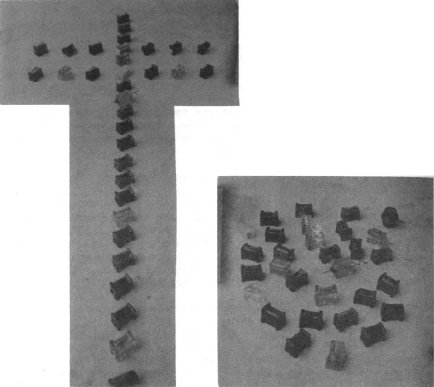
(Left) How's this for a telegraph pole? We had to use all the
blocks in our collection, plus all our spare blocks which are
damaged, to make this photo. (Right) This photo shows the old
threadless egg standing guard over our herd of block glass.
You can easily pick out the Ala. and Ky. block glass from the
Tenn. block glass, as they are much lighter in color, 7 of them,
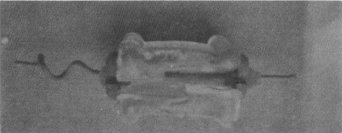
I tried to get a good shot of this one with the wire and
metal pieces on it, but it did not come out too clear.
So Waylon, being a bug-bitten collector at this time,
proceeded to find out where
the antique dealer got the ugly looking pieces of glass he called old telegraph
insulators. This led Waylon to a gentleman who got these old block glass insulators
out of the old railroad station at Gallatin, Tennessee, when it was being torn down.
These insulators were stashed away in an old wooden box in one of the
storerooms; the box had an 1859 date on it. He had quite a few of these insulators
in several different colors. But, since there were three different styles of
block glass
Insulators and an old threadless egg, plus several other insulators in the box, we
could not figure any way to connect the 1859 date to the block glass insulators.
The old railroad station was built In 1850, and this railroad was completed in 1857.
Most of the railroads did not use the telegraph until around 1860. The Peoples
Telegraph was in service in 1848, and since most of the block glass insulators
showed signs of being used, we figured they were just taken out of service and
stashed away in this old storeroom.
As best we can put the picture together, the railroad and the telegraph traveled
the same route between Gallatin, Tennessee, and Nashville, Tennessee. At these
two towns they separated and went their different routes. What we think
happened is that in 1859 the railroad bought this section of telegraph line and
replaced the block glass insulators with another type of insulator.
Anyway, the old fellow had traded off and given away several of the block glass
before Waylon paid him a visit. At this time, Waylon traded him out of six of them
and gave me two. I studied for many hours trying to figure out these old animals
and how they were used. Once I had seen the block glass and found there were
more colors, I knew I would, if at all possible, have to have them. The
gentleman
could not remember how many block glass he had gotten rid of, only the names of
the people he had let have them. All this information I received from him the first
time I met him. Waylon and I proceeded to trade him out of the remaining block glass
he had left and that took over two years and is a long story in itself. To make it short
and give an idea of what went on, I traded everything from a cow out of my angus
herd to just about enough antiques between Waylon and me to stock an entire
antique shop.
I did manage to trail down all the block glass gotten rid of except two. They were
sold by an antique dealer in Gallatin for five dollars each to another antique dealer
who was headed for Alabama.
The gentleman traded away seventeen in four different colors; we
recaptured eight of them. The nine that got away were all green,
except one which was amber; and only the collector that lives in
Sequim, Washington, can tell us the true color of that one. It has
now been about three years since I set out to capture the block
glass. There were eleven different colors in the old box to begin
with, and I now have all these eleven colors in my collection, plus
five colors that were not in this find. I have a total of 18 different block glass in my collection; Waylon has eleven different in his
collection; and when we combine, we have a total of 24 in 16 different colors and three different styles.
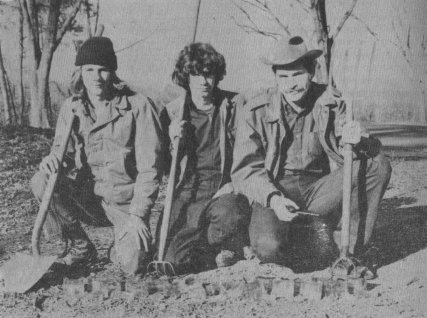
Pictured above (left to right) are Jimmy Morris, Butch House, and
Glenn House. Below you can see the results of their digging--
Alabama block glass insulators.
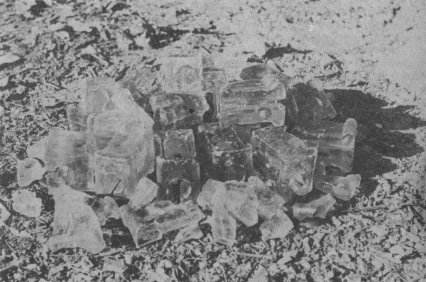
Our total number of block glass in our collections comes to 29 blocks, and that
number represents about one-third of the total number of
block glass that have been found to date that we know of.
The first time I saw the block glass insulator, I thought
to myself they should have called it a lock insulator, as
the insulator has a zig-zag slot in it, and when the wire
is placed in it, it's locked in such a way that it cannot
come out. Also, when looking at the insulator from the
end, it looks like an old type keyhole in an old door.
I have studied many hours in the last three years on the
block glass trying to unravel its secrets. I have gone
through a good-sized stack of early history books and
telegraph books. I still have not been able to pin down
its maker or where it was made, but am almost 100% certain
it was made in the South. The name of the line the block
glass insulators were used on was The Peoples Telegraph.
The wires of this line stretched all the way from
Louisville, Kentucky to New Orleans. The old
telegraph books I have do not give an exact date the line
was constructed, but it mentions this line and another line
from Pittsburgh to New Orleans by another route being
constructed about the same time. It does not give a date
on this, either; but it does give information that there
was a telegraph in service in 1847 in one of the towns
the other line went through. These two telegraph lines in
the early days were in direct competition with each
other. Now here is the fact that gives the block glass
insulators a definite age of not less than 124 years, and
I quote: "It was possible in the year 1848 to hold direct
telegraph communications between New York and New Orleans
by using repeaters." The first mention in this old book of
a repeater being used on telegraph communications was in
Columbus, Georgia, in the year 1847.
Now we know for a fact that the northern end of the
Peoples Telegraph was Louisville, and the southern end
was New Orleans. Now here is the route we think this line
traveled, as block glass have been found along this
route. Some of these towns were not even in existence
when this telegraph line was constructed: from Louisville,
Kentucky, south into Tennessee by way of Gallatin,
Nashville, and down the old Tennessee road into Alabama
through what is now Decataca, Birmingham, Selma,
Mobile, and then over to New Orleans. Block glass insulators
have been found in four of these towns. Using all the
information from all the collectors that I have been in
touch with to date, here are the facts as I have them. To
date 105 block glass insulators have been found.
Where They Were Found
1. One was dug in a dump in
Louisville, Ky.
2. A collector in Louisiana advertised an
amber one; also, another party in Louisiana found two
somewhere between Mobile, Ala., and New Orleans. I have no
more information on these finds.
3. A collector in
Florida had two damaged ones at the National meet last year
- no information on where these were found.
4. One was
found in Mobile, Ala. - no Information on condition or
color.
5. Fifty-seven blocks were found In Gallatin,
Tenn.
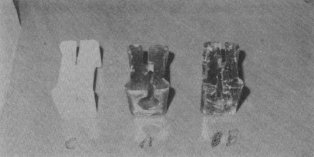
In this photo of style "A". "B", and "C" type block
glass you can see the difference in the wire groove
slots which is reversed on the style "B" block glass.
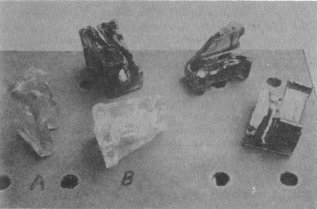
This gives you an idea of what a lot of the damaged
block glass looked like. Items "A" & "B" are in our
collection, as they are the only ones like them.
Item "A" was the one that was dug in Louisville,
Ky. Item "B" is the clear one with a green tint, found
by Glenn House in Alabama.

This photo shows the difference in size of the block glass.
6. Forty blocks have been found in Alabama, not counting the one in Mobile. I don't feel I should give out the information as to where these were found.
7. I have been told a collector in Two Buttes, Colo., has a block glass that is different from the three styles we own, but I have no information on it or where it was found.
Now out of the 105 blocks, there are three styles, and
very possibly a fourth style. The condition of these 105
blocks, on the ones we have information on, runs all the
way from a block glass in good condition to less than a
third of a block glass. To date we have not seen one
block glass insulator in mint condition.
Here is the way these blocks are broken down condition-wise. good condition,
39; fair condition, 5; damaged, 46; unknown, 15, There are
16 different colors known, and 4 different styles: style "A" - 1846; style "B" -
1846 reversed wire slot; style "C" - we think 1859, definitely before 1877, as
this
one is shown in a book printed in 1877;
style "D" - Brookfield or Hemingray shown in Cranfill's, book "Dictionary of
Glass and Ceramic Insulators". We have not seen one of these to date, but we think
the one in Colorado is possibly this style.??
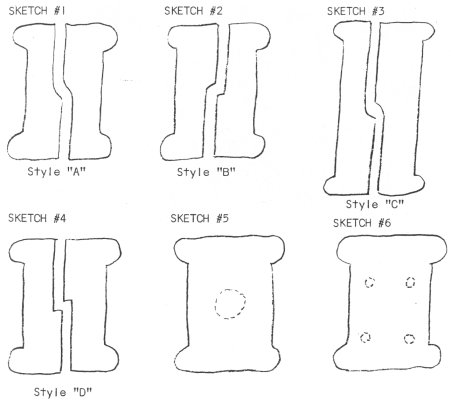
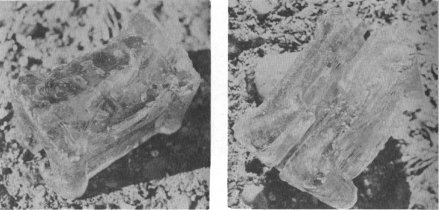
Close-up of aqua glass blocks.
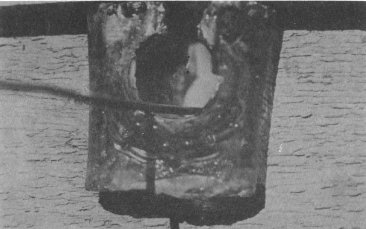
Close-up of glass block in reconstructed cross arm.
The block glass found in Tennessee are like the ones
found in Alabama in style and design, except for the color
and the fact that they were
made in a different mold. All the ones found in Tennessee that I have seen
have a round spot on the bottom, like sketch #5. I assume this round spot was
made by some kind of rod they used to punch it out of the mold. On some of
the insulators this spot shows up real plain, and on others it is very
faint and hard to see.
On the Alabama block glass there is no round spot like sketch #5, but four
little round spots on the bottom of the insulator like sketch #6. On some
of the insulators I have seen, all four spots can be seen; and on some of
them, only one or two of the spots or circles, I should say, can be seen.
I cannot give a break-down on colors of the Alabama and Louisiana block
glass, but I do know that there are three different shades of light aqua,
as I have these three different shades that I got from Mr. Glenn House of
Tuscaloosa, Alabama. I also got a clear one from him that has a very light
green tint in it. Glenn informed me that this was the only one in the bunch
that they found in this color, from this we know that out of the 41 block
glass found in Alabama there were four different colors.
Now I will give a color break-down and rarity of the ones that I have
information on, also condition:
|
Color |
(# known good condition) |
(# known damaged condition) |
Style |
|
Olive green |
1 |
2 |
"A" |
| Yellow green |
1 |
|
"A" |
| Golden yellow amber |
1 |
2 |
"A" |
| Black glass Red amber |
1 |
2 |
"A" |
| Snowy green |
4 |
|
"A" |
| Crystal green |
15 |
14 |
"A" |
| Milk green |
2 |
|
"A" |
| Light milk green |
1 |
1 |
"A" |
| Crystal blue |
1 |
|
"B" |
| Kelly green |
2 |
3 |
"A" |
| Vaseline |
1 |
|
"C" |
| True aqua |
|
1 |
"B" |
|
Clear with green tint |
|
1 |
"A" |
|
Crystal green, 2, condition unknown |
|
|
|
|
Amber, 2, color and condition unknown |
|
|
|
I have seen and held over two thirds of all of the 105 block glass
insulators, and to this day I have not seen two of them that had the exact
same amount of glass in them. The height from bottom to top on these
insulators varies as much as approximately 1/2 of an inch from the
shortest to the tallest.
Here is a list of the towns in which these 105 block glass were last known
to be resting: Cottontown, Gallatin, South Tunnel, Spring City, and
Nashville, Tenn.; Tuscaloosa, Selma, Mobile, Birmingham, Gordo, Foley, and
Baldwin County, Alabama; Central, Tallahassee, Ormand Beach, and Deland,
Fla.; Napa, Ontario, Sacramento, and Chico, Cal.; Pennington, N. J.;
Keyes, Okla.; Montour, and Boise, Idaho; Drummond, Mont.; Lemmon Valley,
Nev.; Cumberland, Iowa; New Hope, Bethlehem, and Parker, Pa.; South Field,
Ludlowville, and Middletown, N. Y.;
Two Buttes, Colo.; Eureka, Kans.; Wallingford, Ct.;
Ogallala, Nebr.; Portland, Ore.; Bremen, Ind.; Sequim,
Wash.; and in southeastern Louisiana.
I believe all the collectors can read this story and draw
their own conclusions on the rarity of the different block
glass that I have mentioned. However, I have heard of
collectors who feel that there are still a lot of blocks
around that just haven't been found yet. Well, I would hope
that they are right, as I feel every collector should have
at least one of these old animals in his collection. However, with my knowledge of the history of the south
between the years 1861 and 1865 I would place the odds of
anyone turning up a lot of the old block glass at about a
million to one. The reasons for these kind of odds are very
simple. Just about all the old telegraph lines in the south
were destroyed by the armies of the north and the south
during these years they were fighting. I would like to ask
all the collectors this question: "How many threadless pin
type insulators do you know of that have been found in the
southeastern states?" I have been looking for over three
years and have looked in all of these southern states, and
to this date I have not yet found that first threadless pin
type insulator and have heard of very few that have been
found. Am also sure that there are other collectors that
now have a block glass insulator that will not find their
town listed on the list of towns of last known locations of
block glass insulators. Some of the collectors in the towns
listed did have more than one block glass, and I'm sure
there has been some selling or trading on some of the spare
block glass. It is also possible that there are one or two
block glass insulators out there somewhere that I haven't
heard about. If there is, I would be interested in hearing
from anybody that has them. I would also like for all the
collectors to keep their eyes open for one old block glass
in S.C.A. It does exist, but to date only a very tiny piece
of one has been found--just enough to prove that it was a
piece of an old block glass. As for the value I place on
all my block glass, I am sure it is much higher than other
collectors would place on them. But, as they say, an
insulator is only worth what a collector is willing to pay,
and I am sure my interest in the old block glass insulators
runs much deeper than other collectors' interest do. To me
this old insulator represents some of man's first efforts
to communicate by wire.
My interest and value I place on the old block glass
insulators runs more in the form of a historical relic than
an insulator.
This is the story of the block glass as it is today, and if
someone should turn up a million block glass, they will
still be at the top of my collection. So with this I leave
all you good "Pole Cats" and "House Cats".
Best Regards to all,
The Cottontown "Pole Cat"
|
